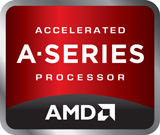
AMD APU
AMD Accelerated Processing Unit (APU), formerly known as Fusion, is a series of 64-bit microprocessors from Advanced Micro Devices (AMD), combining a general-purpose AMD64 central processing unit (CPU) and 3D integrated graphics processing unit (IGPU) on a single die.
Release date
2011 (Original); 2017 (Zen based)
Fusion
Desna
Ontario
Zacate
Llano
Hondo
Trinity
Weatherford
Richland
Kaveri
Godavari
Kabini
Temash
Carrizo
Bristol Ridge
Raven Ridge
Picasso
Renoir
Cezanne
Phoenix
IGP
Wrestler
WinterPark
BeaverCreek
- Desktop E-Series
- Desktop A-Series
- Notebook A, E, C and FX Series
- AMD Athlon with Radeon Graphics
- AMD Ryzen with Radeon Graphics
1 to 8
- 32 nm 1.178B (Llano)
- 32 nm 1.303B (Trinity)
- 32 nm 1.3B (Richland)
- 28 nm 2.41B (Kaveri)
- 14 nm 4.95B (Raven Ridge)
- 12 nm (Picasso)
- 7 nm (Renoir & Cezanne)
- 6 nm (Rembrandt)
- 4 nm (Phoenix)
1.2
4.1+
AMD announced the first generation APUs, Llano for high-performance and Brazos for low-power devices, in January 2011. The second generation Trinity for high-performance and Brazos-2 for low-power devices were announced in June 2012. The third generation Kaveri for high performance devices were launched in January 2014, while Kabini and Temash for low-power devices were announced in the summer of 2013. Since the launch of the Zen microarchitecture, Ryzen and Athlon APUs have released to the global market as Raven Ridge on the DDR4 platform, after Bristol Ridge a year prior.
AMD has also supplied semi-custom APUs for consoles starting with the release of Sony PlayStation 4 and Microsoft Xbox One eighth generation video game consoles.
History[edit]
The AMD Fusion project started in 2006 with the aim of developing a system on a chip that combined a CPU with a GPU on a single die. This effort was moved forward by AMD's acquisition of graphics chipset manufacturer ATI[1] in 2006. The project reportedly required three internal iterations of the Fusion concept to create a product deemed worthy of release.[1] Reasons contributing to the delay of the project include the technical difficulties of combining a CPU and GPU on the same die at a 45 nm process, and conflicting views on what the role of the CPU and GPU should be within the project.[2]
The first generation desktop and laptop APU, codenamed Llano, was announced on 4 January 2011 at the 2011 Consumer Electronics Show in Las Vegas and released shortly thereafter.[3][4] It featured K10 CPU cores and a Radeon HD 6000 series GPU on the same die on the FM1 socket. An APU for low-power devices was announced as the Brazos platform, based on the Bobcat microarchitecture and a Radeon HD 6000 series GPU on the same die.[5]
At a conference in January 2012, corporate fellow Phil Rogers announced that AMD would re-brand the Fusion platform as the Heterogeneous System Architecture (HSA), stating that "it's only fitting that the name of this evolving architecture and platform be representative of the entire, technical community that is leading the way in this very important area of technology and programming development."[6] However, it was later revealed that AMD had been the subject of a trademark infringement lawsuit by the Swiss company Arctic, who used the name "Fusion" for a line of power supply products.[7]
The second generation desktop and laptop APU, codenamed Trinity was announced at AMD's 2010 Financial Analyst Day[8][9] and released in October 2012.[10] It featured Piledriver CPU cores and Radeon HD 7000 series GPU cores on the FM2 socket.[11] AMD released a new APU based on the Piledriver microarchitecture on 12 March 2013 for Laptops/Mobile and on 4 June 2013 for desktops under the codename Richland.[12] The second generation APU for low-power devices, Brazos 2.0, used exactly the same APU chip, but ran at higher clock speed and rebranded the GPU as Radeon HD 7000 series and used a new I/O controller chip.
Semi-custom chips were introduced in the Microsoft Xbox One and Sony PlayStation 4 video game consoles,[13][14] and subsequently in the Microsoft Xbox Series X|S and Sony PlayStation 5 consoles.
A third generation of the technology was released on 14 January 2014, featuring greater integration between CPU and GPU. The desktop and laptop variant is codenamed Kaveri, based on the Steamroller architecture, while the low-power variants, codenamed Kabini and Temash, are based on the Jaguar architecture.[15]
Since the introduction of Zen-based processors, AMD renamed their APUs as the Ryzen with Radeon Graphics and Athlon with Radeon Graphics, with desktop units assigned with G suffix on their model numbers (e.g. Ryzen 5 3400G & Athlon 3000G) to distinguish them from regular processors or with basic graphics and also to differentiate away from their former Bulldozer era A-series APUs. The mobile counterparts were always paired with Radeon Graphics regardless of suffixes.
In November 2017, HP released the Envy x360, featuring the Ryzen 5 2500U APU, the first 4th generation APU, based on the Zen CPU architecture and the Vega graphics architecture.[16]